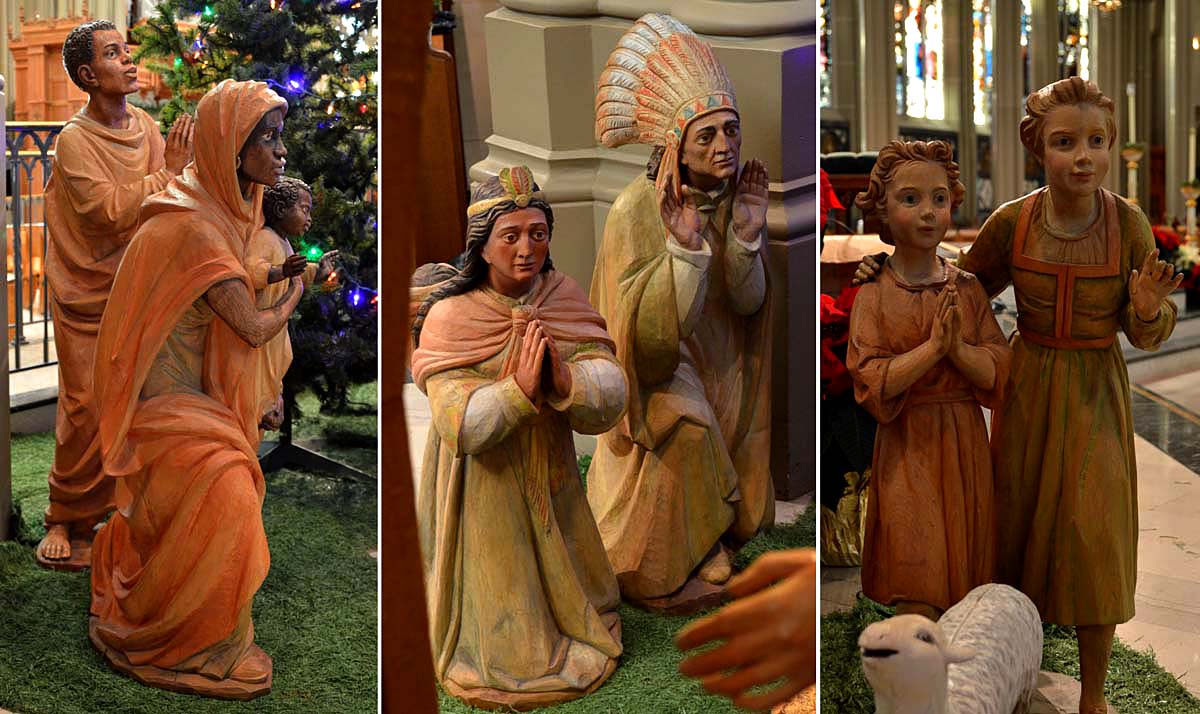
Multi-cultural figures approach the manger in worship. The social change of the 1950’s inspired Bishop Mulloy to incorporate divergent cultures into the message of Christmas. (Photo by Stephen Enzweiler)
by Stephen Enzweiler
Special to NKyTribune
It’s Christmas at the Cathedral Basilica of the Assumption in Covington. It is a time when visitors from all over come to see and enjoy the seasonal decorations beneath its high ceilings and Gothic architecture. For many, a stop here marks the highlight of the season of light: festive red and white poinsettias blanket the candled altar steps, while Christmas trees sparkle in the sanctuary, garlands reach down from above, and beribboned pine garlands curve and drape playfully along the choir lofts and upper galleries.
But tucked in one corner of this French Gothic treasure is a special decoration, one that everyone knows – the manger scene showing the birth of Jesus. Yet, this scene is unusual – and special. In addition to seeing the expected cast of angels, shepherds and Magi, visitors are always surprised to find Sioux Indians, as well as an African family and two small German girls in traditional folk dresses. While the presence of different cultural figures is commonplace in today’s Christmas scenes, in 1959 it was unusual to see anything other than the stereotypic worshipping shepherds, angels and Magi.
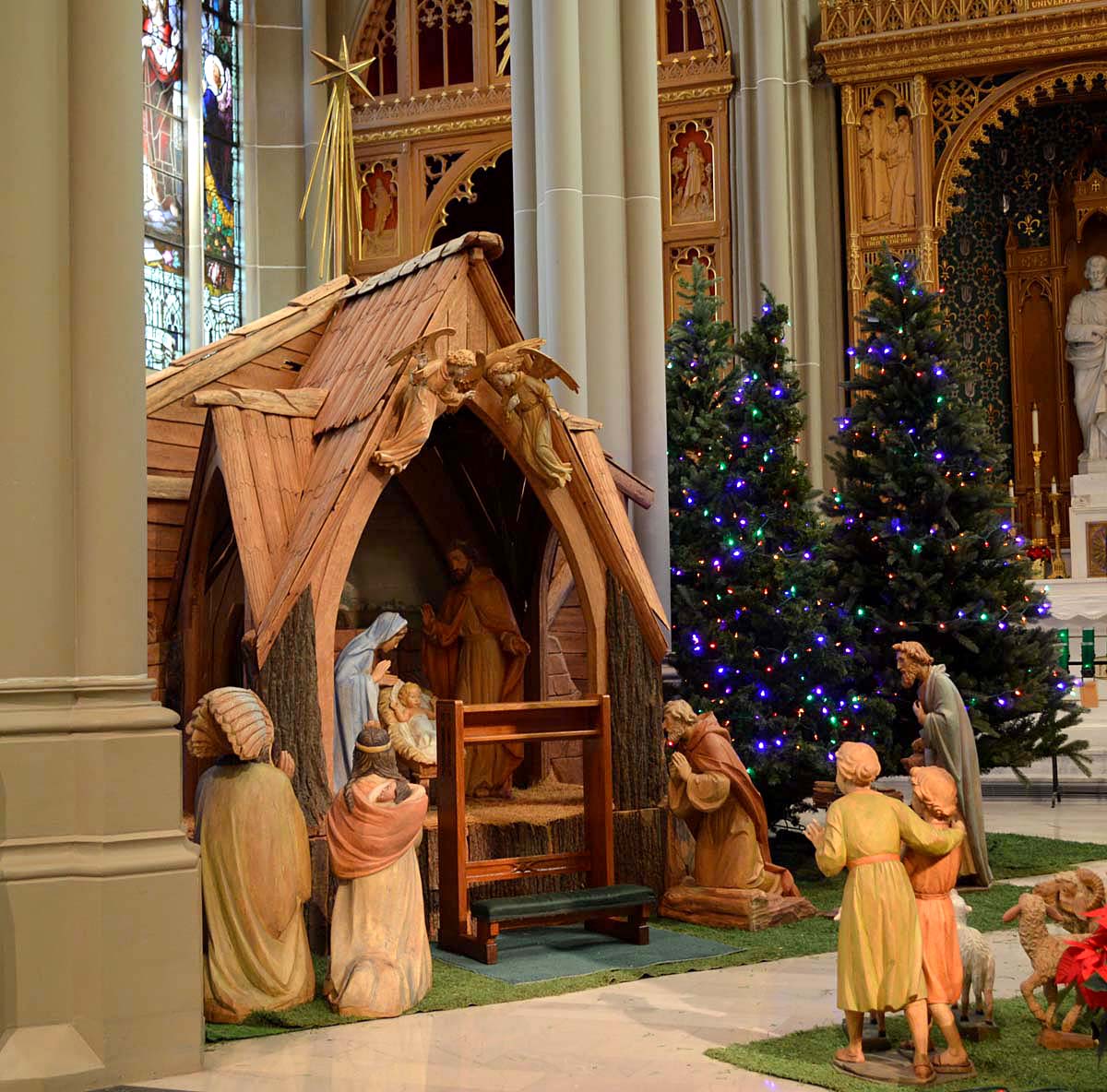
The Star of Bethlehem rises above the Nativity scene and figures carved in Germany of linden wood by August Schmidt. (Photos by Stephen Enzweiler)
On closer examination, the Sioux figures can be traced specifically to the Yankton Sioux tribe of eastern North Dakota. The chief is in full ceremonial headdress patterned to show his tribe; he is on his knees, his eyes wide and hands apart as if gazing at the manger in complete wonder. Beside him is his spouse, kneeling in a buckskin dress, hands folded in prayer and gazing soulfully at the child in the manger. Eagle feathers adorn her braided hair, and on her back she carries her own baby, sleeping in a cradle-board protected by her cloak.
Another set of figures are those of an African family in flowing tribal garb. Unlike the Sioux figures which kneel in adoration, the African family is in motion as if hurrying to see what’s ahead of them. The father gazes in expectation, hands folded in prayer, while the mother carries her baby boy in her arms.
Why are there Sioux Indians here? Why also are there Africans in a Nativity set that had always traditionally displayed Middle Eastern figures of first century Palestine? And who carved them? It turns out, the Cathedral Basilica’s manger scene owes its existence to two men – the Most Reverend William T. Mulloy, sixth Bishop of Covington, and August A. Schmidt, a German-born woodcarver and sculptor living in Hyattsville, Maryland.
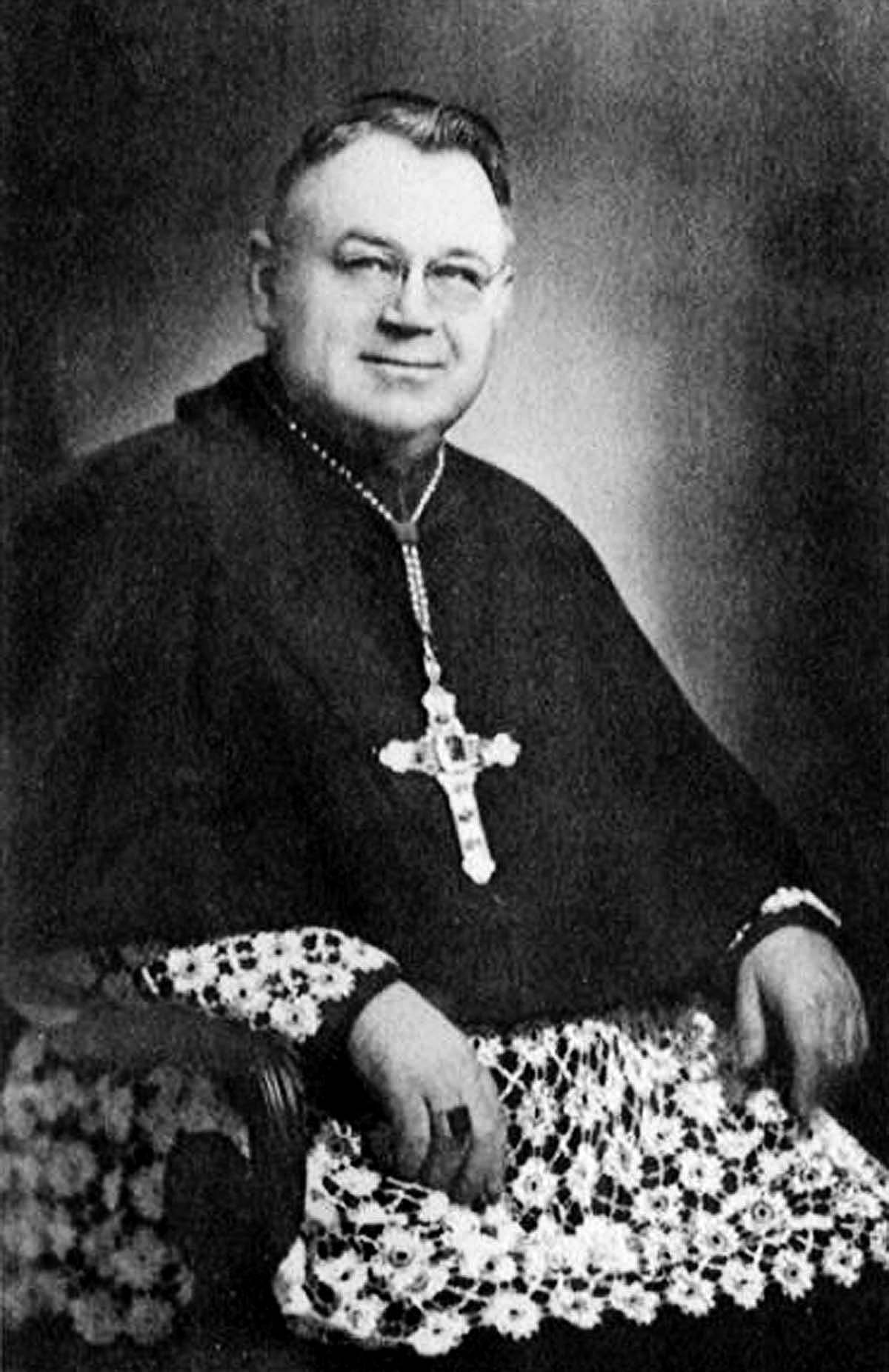
Most Rev. William T. Mulloy, the sixth Bishop of Covington. Courtesy of the Kenton County Public Library.
Bishop Mulloy was well known for his high energy and dominating personality. But he was also known for his deep care and concern for the spiritual lives of his flock. His tenure as Covington’s bishop was marked by his creation of new religious institutions such as St. Pius X Seminary, Marydale, and the enlarging of St. Elizabeth hospital. He also expanded Catholic education reforms, especially in the rural areas of eastern Kentucky. But what he is perhaps most remembered for are his sweeping renovations to the Cathedral during the decade of the 1950s. Most notable of these were the addition of an ornately carved baldachino, choir stalls, altar carvings, ambo . . . and the creation of the Nativity scene we see today.
William Theodore Mulloy was born on November 9, 1892 in Ardoch, North Dakota. He was the first of five children born to William James and Margaret Mulloy, who emigrated from Ontario to the Dakota Territory in 1889. William’s world as a child was that of rural farm life and close associations with the native peoples of the Sioux nation. He heard the call to the priesthood early in life, and by age 14 was certain of his life’s direction and attacked it with zeal. While attending St. Paul Seminary in Minneapolis, he ranked third in his class and earned a reputation for his boundless energy, piercing intelligence and zealous devotion to God. He was ordained a priest by Bishop James Riley of Fargo, North Dakota on June 7, 1916.
In those days, the Catholic church was widely scattered across the Dakotas, comprised mainly of farmers and native populations of Lakota, Hunkpapa and Yankton Sioux. In 1934, he was appointed Diocesan Director of Rural Life, and later helped organize the Confraternity of Christian Doctrine (CCD), which aimed at teaching the faith to rural populations consisting mainly of white farmers and tribal Sioux populations. His fondness for the Sioux people was closely shared by his mentor, Fargo’s Bishop Aloysius Muench. When Fr. Mulloy was appointed Bishop of Covington in August 1944, those sentiments followed him here from his North Dakota home.

Photo by Stephen Enzweiler
August Schmidt had known the future Bishop Mulloy while working for Bishop Muench on renovations to Fargo’s cathedral in 1939. Mulloy, who was then the Cathedral’s rector, worked closely with Schmidt and came to know him well. August Schmidt was born in Cologne, Germany, and was a highly skilled designer and woodcarver who had his studio in Hyattsville, Maryland. He often traveled back to Cologne to commission work of carvers there, and Bishop Mulloy kept Schmidt busy for almost all of his time as Bishop of Covington. “You will be having much work,” Mulloy wrote to his friend, “and the longer you stay in this country the more you will have, so you will never be idle.”
It was into this constant stream of work that the idea for the crib scene emerged. “I have in mind a very beautiful crib for the cathedral,” the bishop wrote Schmidt in January 1954. “Perhaps you could give me a rough sketch and an estimate of these.” Over the next three years, the development of this crib scene and its figures would evolve. At first Schmidt executed drawings only for the manger and figures of St. Joseph, Mary and child, shepherds and a few sheep. By 1957, with added donations from parishioners, he was able to add the extra figures he wanted. A wax model by Schmidt followed for the bishop’s evaluation; then a smaller, tabletop model carved in wood.

Photo by Stephen Enzweiler
In a letter from November 1958, Schmidt lists the final figures being carved to include, “Mary, Joseph and the child, two floating angels, 3 shepherds including a young one and flute, one shepherd holding a small lamb, 5 sheep, one shepherd family with two children, the three holy Magi, one negro family and one Indian family. A star with rays from metal, Background sloping up with the city of Bethlehem in the back.” He worked furiously to complete the crib scene, which the bishop wanted finished by the summer of 1959. But lack of available artists and materials delayed the work. Schmidt was having the entire crib set carved back in Cologne, Germany, and he traveled constantly back and forth in order to supervise the progress of the work and arrange for shipment of the finished pieces. It all took time.
Sadly, Bishop Mulloy would not live to see his crib scene displayed at the Cathedral. In May 1959, after returning from Lexington where he had been delivering a commencement address, he was taken to the hospital after tests revealed a blood clot in his heart. After a restless week, he died on June 1st. The finished crib scene he originally envisioned in 1954 would not be delivered to the Cathedral Basilica until that November. This is the crib scene we see on display today.
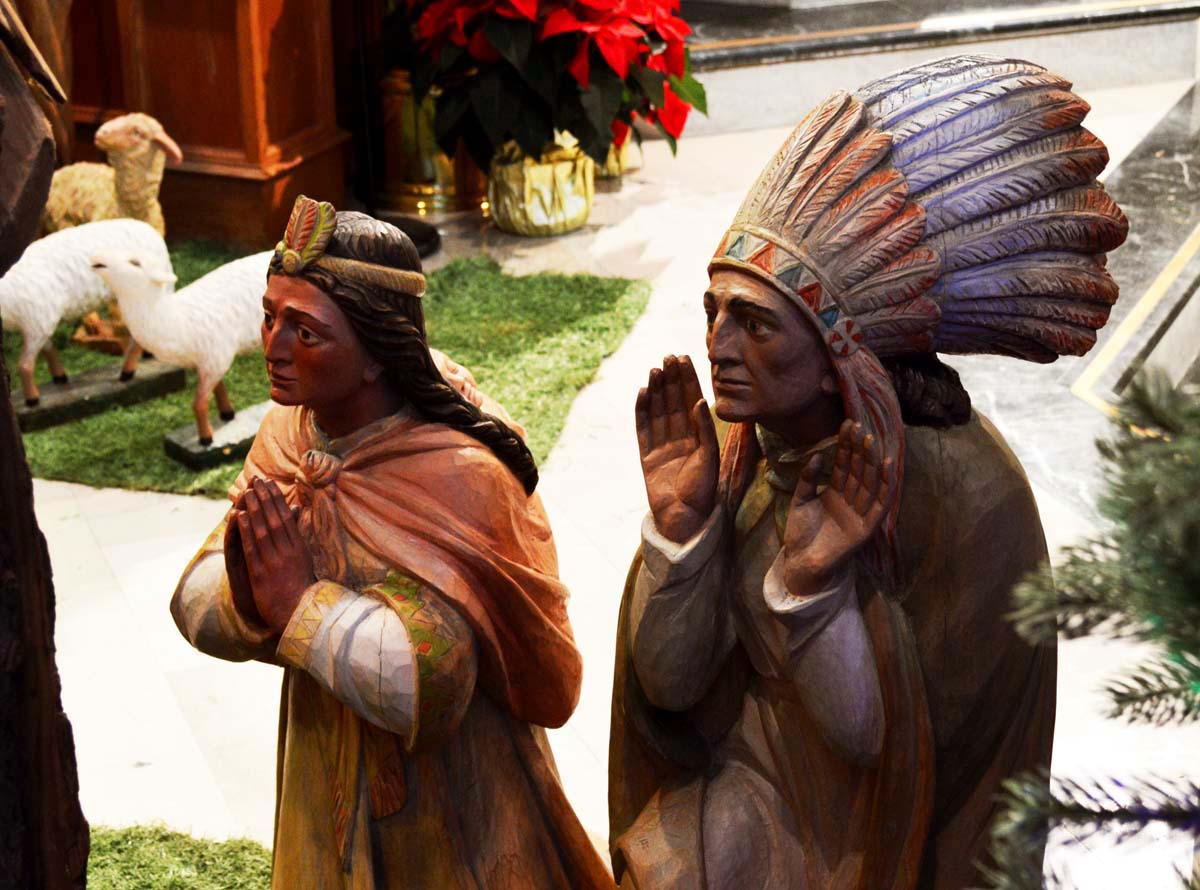
The Sioux family approach the manger. (Photo by Stephen Enzweiler)
The Cathedral Basilica’s Nativity scene that we see today is not just a visual representation of the story of the first Christmas. The American culture had been changing in big ways in the 1950’s and Bishop Mulloy saw this. It was during those dramatic social changes that he seized upon the opportunity to express his vision for a greater inclusion of people of all races and cultures into the message of peace and joy brought to the world two thousand years ago by “that child born in Bethlehem.” It is pure Bishop Mulloy. The Sioux and African families and small German children we see approaching the child in the crib are his reminder to us today of our need to love and care for all people, especially those whom his mentor, Bishop Muench, once called “the forgotten among us.”
Stephen Enzweiler is a writer and journalist. He has been a columnist for the Kentucky Enquirer, the Oxford Citizen, and was a senior editor at Y’all Magazine. He is the author of “Oxford in the Civil War: Battle for a Vanquished Land (2010).

Detail of one of the African sculptures. (Photo by Stephen Enzweiler)/em>

Shepherd. (Photo by Stephen Enzweiler)
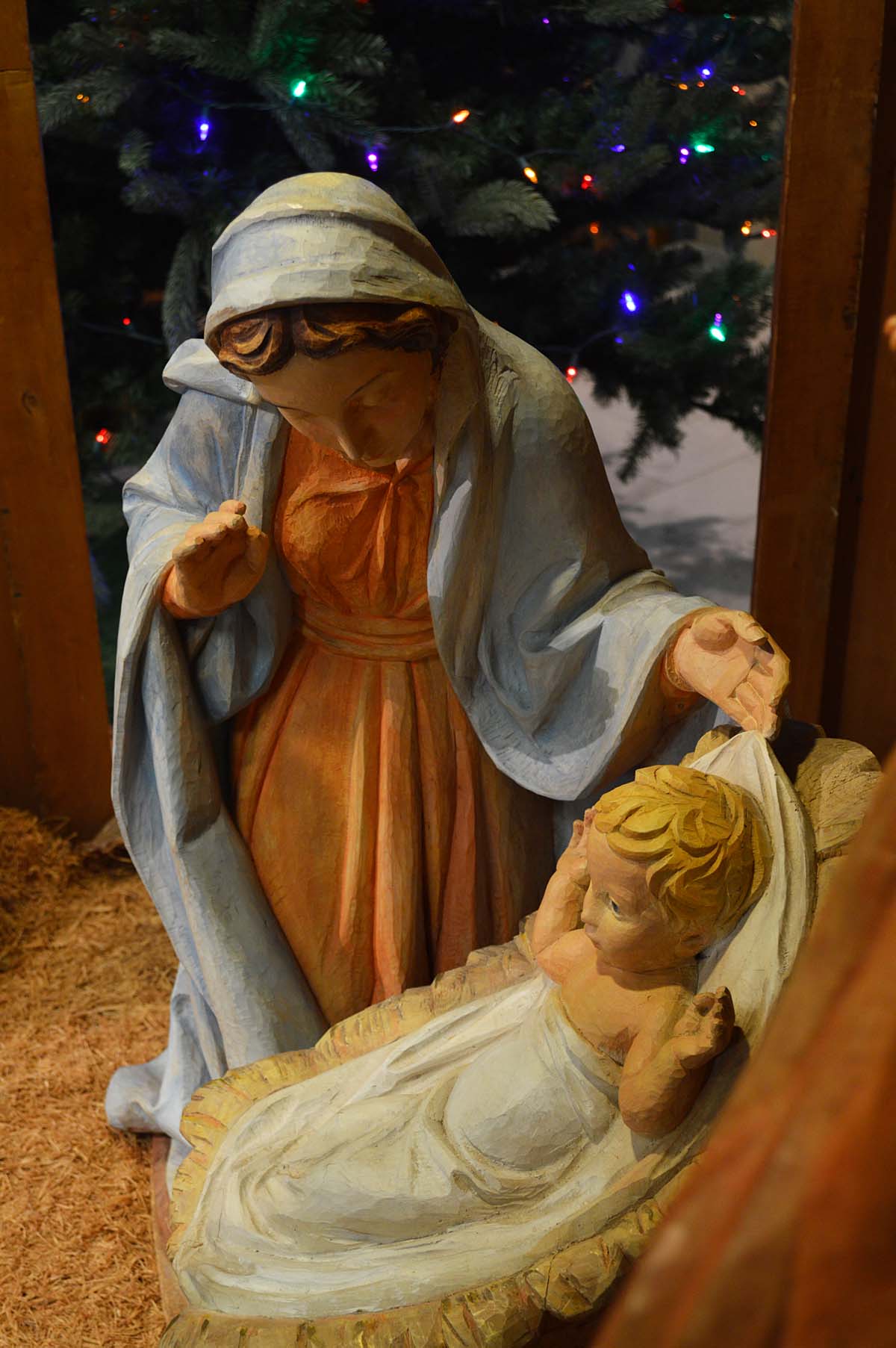
Mary and the Child Jesus. (Photo by Stephen Enzweiler)

























FANTASTIC as always Steve – enjoyed it very much – keep them coming!!